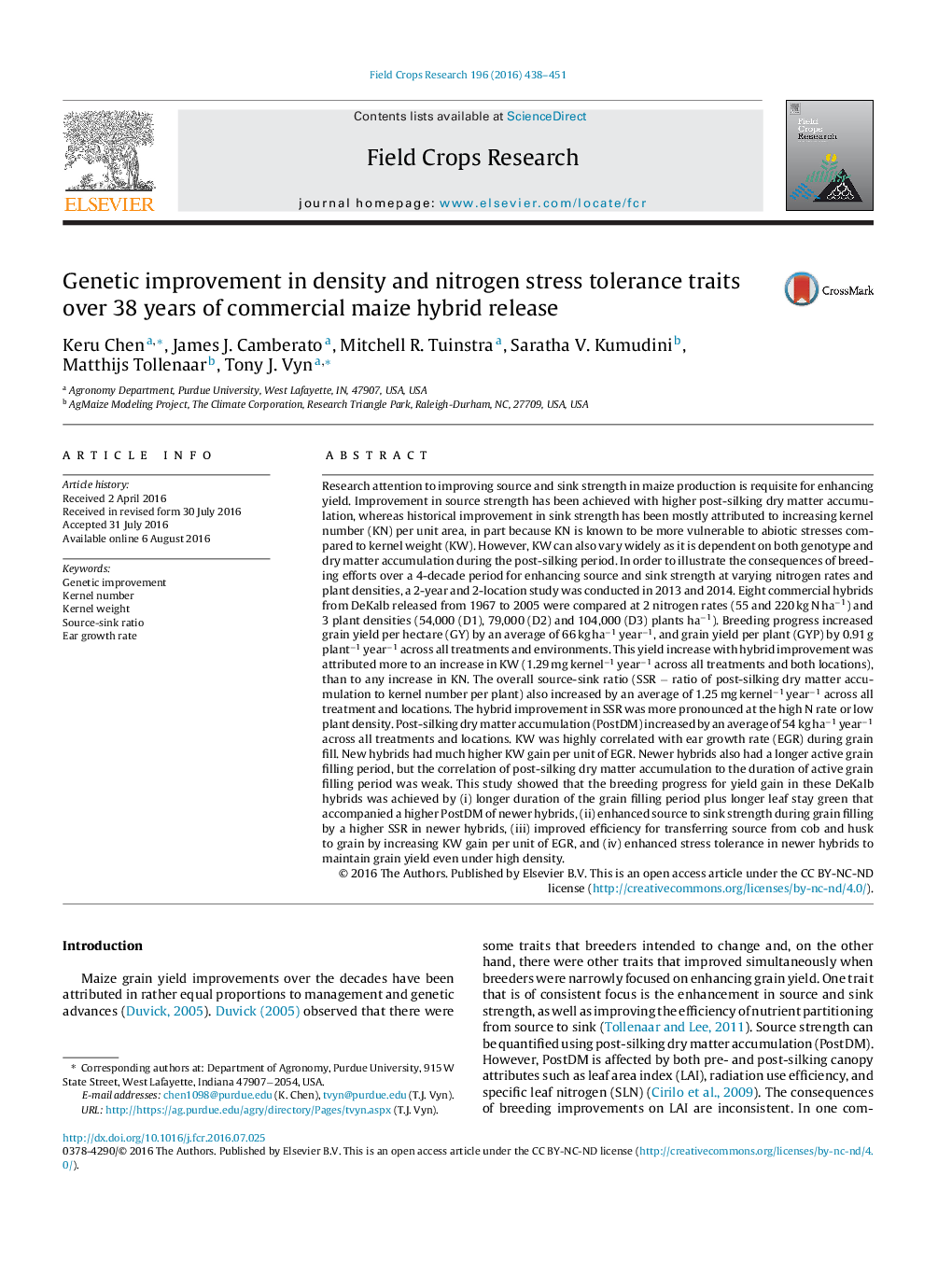| کد مقاله | کد نشریه | سال انتشار | مقاله انگلیسی | نسخه تمام متن |
|---|---|---|---|---|
| 6374575 | 1624667 | 2016 | 14 صفحه PDF | دانلود رایگان |
عنوان انگلیسی مقاله ISI
Genetic improvement in density and nitrogen stress tolerance traits over 38 years of commercial maize hybrid release
ترجمه فارسی عنوان
بهبود ژنتیکی در تراکم و مقاومت به تنش نیتروژن بیش از 38 سال انتشار تجاری ترکیبی ذرت است
دانلود مقاله + سفارش ترجمه
دانلود مقاله ISI انگلیسی
رایگان برای ایرانیان
کلمات کلیدی
بهبود ژنتیکی، تعداد هسته، وزن هسته، نسبت سینک منبع، نرخ رشد گوش،
موضوعات مرتبط
علوم زیستی و بیوفناوری
علوم کشاورزی و بیولوژیک
علوم زراعت و اصلاح نباتات
چکیده انگلیسی
Research attention to improving source and sink strength in maize production is requisite for enhancing yield. Improvement in source strength has been achieved with higher post-silking dry matter accumulation, whereas historical improvement in sink strength has been mostly attributed to increasing kernel number (KN) per unit area, in part because KN is known to be more vulnerable to abiotic stresses compared to kernel weight (KW). However, KW can also vary widely as it is dependent on both genotype and dry matter accumulation during the post-silking period. In order to illustrate the consequences of breeding efforts over a 4-decade period for enhancing source and sink strength at varying nitrogen rates and plant densities, a 2-year and 2-location study was conducted in 2013 and 2014. Eight commercial hybrids from DeKalb released from 1967 to 2005 were compared at 2 nitrogen rates (55 and 220 kg N haâ1) and 3 plant densities (54,000 (D1), 79,000 (D2) and 104,000 (D3) plants haâ1). Breeding progress increased grain yield per hectare (GY) by an average of 66 kg haâ1 yearâ1, and grain yield per plant (GYP) by 0.91 g plantâ1 yearâ1 across all treatments and environments. This yield increase with hybrid improvement was attributed more to an increase in KW (1.29 mg kernelâ1 yearâ1 across all treatments and both locations), than to any increase in KN. The overall source-sink ratio (SSR â ratio of post-silking dry matter accumulation to kernel number per plant) also increased by an average of 1.25 mg kernelâ1 yearâ1 across all treatment and locations. The hybrid improvement in SSR was more pronounced at the high N rate or low plant density. Post-silking dry matter accumulation (PostDM) increased by an average of 54 kg haâ1 yearâ1 across all treatments and locations. KW was highly correlated with ear growth rate (EGR) during grain fill. New hybrids had much higher KW gain per unit of EGR. Newer hybrids also had a longer active grain filling period, but the correlation of post-silking dry matter accumulation to the duration of active grain filling period was weak. This study showed that the breeding progress for yield gain in these DeKalb hybrids was achieved by (i) longer duration of the grain filling period plus longer leaf stay green that accompanied a higher PostDM of newer hybrids, (ii) enhanced source to sink strength during grain filling by a higher SSR in newer hybrids, (iii) improved efficiency for transferring source from cob and husk to grain by increasing KW gain per unit of EGR, and (iv) enhanced stress tolerance in newer hybrids to maintain grain yield even under high density.
ناشر
Database: Elsevier - ScienceDirect (ساینس دایرکت)
Journal: Field Crops Research - Volume 196, September 2016, Pages 438-451
Journal: Field Crops Research - Volume 196, September 2016, Pages 438-451
نویسندگان
Keru Chen, James J. Camberato, Mitchell R. Tuinstra, Saratha V. Kumudini, Matthijs Tollenaar, Tony J. Vyn,
